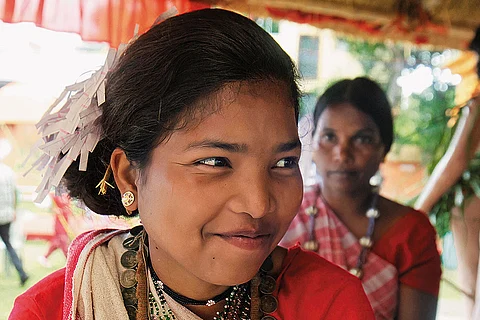
- Destinations
- Experiences
- Stay
- What's new
- Celebrating People
- Responsible Tourism
- CampaignsCampaigns
- Subscribe
- Buy Now

Their calloused hands deftly weave ropes that tether domesticated animals like cows and buffaloes. They live in leaf-thatched houses on the edges of forests. Their knowledge of Indigenous plants in the Jharkhand and Odisha forest belts, where they live, surpasses any others. The Birhor community is a marginal upajati who speak the Birhor language, which is low in the hierarchy of Austro-Asian languages and will soon be extinct if not for the laborious efforts of language crusader Bikram Jora, a linguist with a doctorate from Delhi University.
Similarly, the Asur language, another in the family of Austro-Asian languages, is being conserved and revived by community radio broadcasts led by activist-poet-author Vandana Tete. Pre-recorded plays, songs, and news scripts are played over loudspeakers at weekly haats in villages of Jharkhand to popularise the endangered language spoken by about 9,500 members of the Asur community.
The Asurs, a Particularly Vulnerable Tribal Group (PVTG) in Jharkhand's Netarhat, Latehar, Palamu, and Gumla districts, were once iron smelters but now practice agriculture. They live on society’s margins yet maintain a unique culture, with distinct rituals and traditions.
Working among them, Tete started a community radio programme in 2019. "Asur Adivasi Radio was started by 15 members of the Asur community—mainly daily wage earners, farmers, and housewives—who record songs in the Asur language. They bring the recordings on pen drives to weekly bazaars and play them over loudspeakers to help the community, especially the youth, connect with their language," she said over the phone from a remote corner of Jharkhand.
"People are now writing new songs in Asur and also singing them, uploading them on social media like YouTube," Tete added. "Attempts are being made to collect poems, mantras, shlokas, and modes of rituals and rites practised by the community. The tribe's history is being written in the form of songs, and customs are being documented."
Talking of introducing Asur in primary schools since Mother Tongue Based Multilingual Education (MTBME) is being promoted as part of the National Education Policy (NEP), Tete said: "We are still nowhere near getting Asur into primary education. It is imperative that children learn in their mother tongue till the primary level and then go on to learn Hindi and English at the secondary level. But we are still far away from that."
Tete aims to expand Radio Asur to every village in Jharkhand but faces funding challenges. She explained, “It’s expensive and difficult to catch mobile signals and radio frequencies here, so we decided to use public address systems instead.” Efforts are also underway to create children’s books in Asur, similar to those for Birhor.
Meanwhile, Jora said the Birhor language is facing extinction due to pressure from dominant languages like Hindi, Sadri, Santhali, and Munda. With around 10,000 Birhors in Jharkhand, most are gradually abandoning their language, which is now mainly spoken by older community members. The Birhors, nomadic hunter-gatherers, are being forced out of their forest land.
Jora, who joined the Living Tongues Institute for Endangered Languages (livingtongues.org) in 2010 and has worked on the Birhor project since 2018, said, “They practice sustainable livelihoods, never cut trees, and have vast plant knowledge. They understand their survival depends on the forest.” He travelled across Ranchi, Hazaribag, and Singbhum to work with the Birhors. He noted they are primarily rope makers, selling ropes made from tree bark for `100–150 per bundle to the Santhals, Mundas, and Hos.
Jora has published two books: a children’s picture book "Abun Ari Re" (Our Surroundings) and a survey on the Birhor community’s ethno-botanic knowledge. Five hundred copies of the picture book were distributed free across six Jharkhand districts, including to primary schools. “The community is now asking for storybooks,” he said. Jora also encourages families to use the book to teach children Birhor, with illustrations showing body parts labeled in both Hindi and Birhor. A dictionary and grammar book are also in progress.
